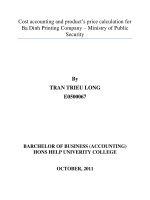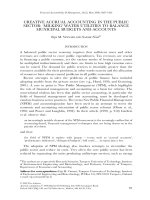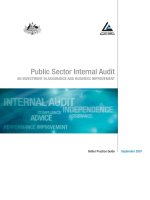Accrual accounting and public sector reform
Bạn đang xem bản rút gọn của tài liệu. Xem và tải ngay bản đầy đủ của tài liệu tại đây (1.39 MB, 341 trang )
ACCRUAL ACCOUNTING AND PUBLIC SECTOR
REFORM:
NORTHERN TERRITORY EXPERIENCE
Ali Rkein
(Bachelor of Business and Finance, Master of Accounting Studies, Master of
Business Administration in Finance)
School of Law and Business
Faculty of Law, Business and Arts
Charles Darwin University
A thesis submitted in fulfilment of the requirements for the degree
of
Doctor of Philosophy
May 2008
Declaration
I hereby declare that the work herein, now submitted as a thesis for the degree of
Doctor of Philosophy of the Charles Darwin University, is the result of my own
investigations, and all references to ideas and work of other researchers have been
specifically acknowledged. I hereby certify that the work embodied in this thesis
has not already been accepted in substance for any degree, and is not being
currently submitted in candidature for any other degree.
________________________________
Ali Rkein
May 2008
ii
Abstract
The reform of the public sector has been a continuing challenge for many
governments around the world. In recent years, this reform has become dominated
by such terms as ‘new public management’, ‘managerialism’, ‘marketisation’,
‘privatisation’ and ‘commercialisation’. These terms reflect a broadly-based
commercial direction that governments started taking in response to reform’s
pressures resulting from a perceived crisis of legitimacy, responsiveness,
efficiency and accountability in public sectors. A significant feature of this
commercial orientation was the adoption of private sector practices and economic
market models by governments and public sector organisations. The underlying
principle was competition. Governments believed that competition plays a major
role in improving organisational performance, and by subjecting government
organisations to relevant forms of competition they would become more cost
conscious and results focused, leading to increased efficiency, effectiveness and
accountability.
In Australia, this commercial orientation has taken momentum with the
introduction of the National Competition Policy, which advocated that to become
more economic, efficient and effective, public sector organisations should operate
on the same commercial principles as the private sector. In this regard, the policy
required Australian governments to ensure competitive neutrality by eliminating
resource allocation distortions arising out of government ownership, such as tax
exemptions, regulatory advantages, discounted interest rates on loans, and crosssubsidization.
Accounting has been a key element of this reform process, with a change being
required as the traditional cash accounting system was not capable of providing
the additional financial information that was needed as a result of the commercial
orientation. In this regard, governments in Australia have introduced a
commercial accounting system through the adoption of accrual-based accounting,
budgeting and reporting practices. At first, the adoption of these practices started
in organisations that provide business-like services and are in competition with
private providers. At a later stage, Australian governments started also to
introduce the practices into their whole public sector.
iii
While accrual accounting was believed to be useful in a competitive operating
environment, this study aims to analyse its working in the Northern Territory of
Australia where competition is very limited. The high cost of production resulting
from a relatively small and dispersed population and the lack of economies of
scale have resulted in a small private sector in the Territory. This has made the
provision of many government services driven more by social imperatives than
economic imperatives. In this regard, the study intends to assess the extent that
commercial accounting practices have achieved their intended reform objectives.
This study highlights a number of findings based on an assessment of the
Northern Territory public sector’s responses overall, supported by more detailed
analyses of accounting changes in two departments. First, the small private sector
in the Northern Territory has not supported the creation of a competitive market
for most government goods and services. Second, although accrual accounting has
been able to provide full cost information, the heterogeneity of some government
services has resulted in a questionable full cost figure. The use of full cost in
pricing has not achieved its intended benefits because of the absence of
competitive market pressures. Also, the use of cost information in benchmarking
has been fragile, mainly because higher costs of services are the result of ‘capital
cost disabilities’ that exist in the Northern Territory and may have nothing to do
with performance efficiency. Third, this study shows that accrual budgeting has
not been used properly and therefore it has failed to achieve its objectives. Finally,
while accrual reporting has improved the completeness of the accounting
information available, especially at the whole of government level, it has not
changed much from cash reporting in discharging accountability at organisational
and whole of government levels.
iv
Acknowledgements
Many people have contributed directly and indirectly to the production of this
thesis and it could not have finished without their assistance and patience, to all I
am eternally grateful.
First, I would like to thank my supervisors Professor Brian Andrew, Professor Ian
Thynne, and Associate Professor Ram Vemuri. I am very grateful to you Brian
and I would like to express my sincere appreciation and deepest thanks for your
encouragement, wisdom and support that went beyond anything I could have
expected. Your good sense, your generosity with time and ideas helped me to
bring this work to life. Ian, thank you for your insightful comments and probing
questions which resulted in significant contributions to the development of this
thesis, and also for your excellent contributions to the ordering and presentation of
ideas. I can not adequately express my gratitude to you Ram for your undying
belief in me in those moments I was riddled with self-doubt, for your motivation
that often meant the difference between progress and stagnation when my energy
and interest faded away.
Second, I would like to thank the School of Law and Business at Charles Darwin
University for giving me the opportunity to teach and gain invaluable experience
while undertaking my PhD. Also, I am indebted for the support and
encouragement of my colleagues, especially Professor Gweneth Norris.
Third, a special thanks to all staff at the Department of Corporate and Information
Services, the Department of Health and Community Services, and other Northern
Territory government agencies, who agreed to participate in this study and
devoted their time to provide me with the relevant information required to
complete this thesis.
Finally, I would like to thank my parents for their encouragement and support,
especially my father who instilled in my mind the determination to pursue the
PhD level from long time ago. A special thanks to my wife Leila and my two
daughters Fatima and Mariam, to whom I dedicate this thesis, for their love,
support and patience.
v
Table of Contents
Declaration .................................................................................................................... ii
Abstract ...................................................................................................................... iii
Acknowledgements ....................................................................................................... v
Table of Contents ......................................................................................................... vi
Table of Tables.............................................................................................................. x
Table of Figures ........................................................................................................... xi
List of Acronyms and Abbreviations .......................................................................... xii
Chapter 1
Introduction ........................................................................... 1
1.1
Background to the Study............................................................................... 1
1.2
Research Motivation ..................................................................................... 7
1.3
Research Questions ....................................................................................... 9
1.4
Importance of the Study .............................................................................. 10
1.5
Outline of the Thesis ................................................................................... 11
Chapter 2
International Trends in Public Sector Reform..................... 15
2.1
Introduction ................................................................................................. 15
2.2
Public Sector Reform, an International Perspective ................................... 17
2.2.1
Reform Pressures .........................................................................................18
2.2.2
Reform Responses........................................................................................24
2.3
Organisational Change as a Key Component of Public Sector Reform...... 28
2.4
Organisational Performance: Accounting & Accountability ...................... 34
2.4.1
Elements of Performance .............................................................................34
2.4.2
Accounting as a Key Element ......................................................................37
2.4.3
Underlying Significance of Accountability .................................................50
2.5
Conclusion................................................................................................... 53
vi
Chapter 3
Public Sector Reform: Australian Responses ..................... 55
3.1
Introduction ................................................................................................. 55
3.2
Public Sector Reform, an Australian Perspective ....................................... 56
3.2.1
Drivers of Reform ........................................................................................56
3.2.2
Reform Responses........................................................................................59
3.3
Organisational Change ................................................................................ 70
3.4
Organisational Performance and Accounting Change ................................ 75
3.4.1
Organisational Performance.........................................................................75
3.4.2
Accounting Responses .................................................................................80
3.5
Conclusion................................................................................................... 96
Chapter 4
Methodology and Theory .................................................... 98
4.1
Introduction ................................................................................................. 98
4.2
Approach to Research ................................................................................. 99
4.3
Case Studies and Data Collection ............................................................. 102
4.3.1
Case Study Interpretive Approach .............................................................102
4.3.2
Data Collection...........................................................................................107
4.4
Theories and Accounting Research........................................................... 109
4.5
Organisational Change Focus ................................................................... 111
4.6
Immediate Relevance of Theories and Models......................................... 117
4.7
Research Site............................................................................................. 121
4.8
Summary ................................................................................................... 123
Chapter 5
Northern Territory Public Sector Reform ......................... 124
5.1
Introduction ............................................................................................... 124
5.2
Northern Territory Profile ......................................................................... 125
5.3
Northern Territory Public Sector .............................................................. 127
5.4
Institutional Pressures for Reform ............................................................ 129
vii
5.5
Organisational Responses in the NT Public Sector................................... 131
5.5.1
Privatisation................................................................................................132
5.5.2
Outsourcing ................................................................................................134
5.5.3
National Competition Policy and the Organisational Reform ...................138
5.5.4
Corporatisation and Commercialisation.....................................................142
5.6
Management and Accounting Responses in the Northern Territory
Public Sector ............................................................................................. 147
5.6.1
Main Management and Accounting Initiatives ..........................................148
5.6.2
Last Government to Adopt the Change......................................................152
5.7
Working for Outcomes Framework .......................................................... 156
5.7.1
Outputs .......................................................................................................157
5.7.2
Performance ...............................................................................................159
5.7.3
Accruals......................................................................................................161
5.8
Conclusion................................................................................................. 168
Chapter 6
The Usefulness of Accrual Accounting in DCIS – an
Internal Shared Services Provider – .................................. 172
6.1
Introduction ............................................................................................... 172
6.2
Historical Background .............................................................................. 173
6.3
Accrual Accounting .................................................................................. 178
6.3.1
Criteria for Usefulness of Accounting Information ...................................180
6.3.2
Accrual Accounting Relevance to Decision Making .................................183
6.3.3
The Rationale for Full Cost Information....................................................193
6.4
Accrual Budgeting .................................................................................... 204
6.4.1
Greater Customer Focus.............................................................................207
6.4.2
Better Resource Allocation ........................................................................211
6.4.3
Enhanced Performance and Accountability ...............................................221
6.5
Accrual Reporting ..................................................................................... 223
6.5.1
Financial Reporting....................................................................................224
viii
6.5.2
Output Reporting........................................................................................231
6.6
Conclusion................................................................................................. 235
Chapter 7
Department of Health and Community Services: The
Domination of Social Responsibility ................................ 239
7.1
Introduction ............................................................................................... 239
7.2
Historical Background .............................................................................. 240
7.3
Unique Environment ................................................................................. 241
7.4
Social Responsibility of DHCS................................................................. 246
7.5
Usefulness of Accounting Information in DHCS ..................................... 248
7.5.1
Operational Relations between DHCS and DCIS......................................249
7.5.2
Accrual Accounting ...................................................................................251
7.5.3
Accrual Budgeting .....................................................................................258
7.5.4
Accrual Reporting ......................................................................................260
7.6
Conclusion................................................................................................. 263
Chapter 8
Summary and Conclusion ................................................. 265
8.1
Summary and Discussion of Findings....................................................... 265
8.1.1
Accrual Accounting ...................................................................................269
8.1.2
Accrual Budgeting .....................................................................................273
8.1.3
Accrual Reporting ......................................................................................276
8.2
Conclusion................................................................................................. 278
Appendices................................................................................................................ 283
Bibliography.............................................................................................................. 298
ix
Table of Tables
Table 1 Series of statements of accounting concepts............................................ 85
Table 2 Development trend of government accounting (AAS) ............................ 90
Table 3 Strategic responses to institutional processes. ....................................... 114
Table 4 Example of outputs list at DHCS........................................................... 158
Table 5 Example of performance measures of an output.................................... 160
Table 6 List of financial statements before accrual accounting .......................... 165
Table 7 Comparison between budgeted capital appropriation and actual capital
asset purchases. ....................................................................................... 214
Table 8 Budget outcome to cash reconciliation .................................................. 216
Table 9 Reconciliation of accrual deficit and accrual deficit at DCIS................ 218
Table 10 Average salary across states and territories ......................................... 243
Table 11 Number of public and private hospitals by states and territories......... 244
Table 12 Medical practitioners by sector across states and territories in 2005... 245
x
Table of Figures
Figure 1 Model for understanding organisational change................................... 115
Figure 2 Map of Australia. .................................................................................. 126
Figure 3 Example of outcome/output structure at DHCS ................................... 158
Figure 4 Sources of revenue at DCIS.................................................................. 185
xi
List of Acronyms and Abbreviations
AARF
Australian Accounting Research Foundation
AAS
Australian Accounting Standard
AASB
Australian Accounting Standards Board
ABC
Activity Based Costing
ABS
Australian Bureau of Statistics
ACT
Australian Capital Territory
AR-DRG
Australian Refined-Diagnosis Related Group
ATM
Accounting Theory Monograph
CHA
Central Holding Authority
COAG
Council of Australian Governments
CPA
Competition Principles Agreement
CTC
Competitive Tendering and Contracting
DCIS
Department of Corporate and Information Services
DHCS
Department of Health and Community Services
DP
Discussion Paper
DRG
Diagnosis Related Group
ED
Exposure Draft
FASB
Financial Accounting Standards Board
FMIP
Financial Management Improvement Program
FTE
Full Time Equivalent
GAS
Government Accounting System
GBD
Government Business Division
GDP
Gross Domestic Product
GFS
Government Finance Statistics
GOC
Government Owned Corporation
GSP
Gross State Product
IASB
International Accounting Standards Board
ICD
International Classification of Diseases
IMF
International Monetary Fund
IT
Information Technology
JCPA
Joint Committee of Public Accounts
MBO
Management by Objectives
MLFR
Merrill Lynch and Fay Richwhite
NCP
National Competition Policy
NPM
New Public Management
NT
Northern Territory
xii
NZ
New Zealand
OECD
Organisation for Economic Cooperation and Development
PAWA
Power and Water
PIPS
Personnel Integrated Payroll System
PMB
Program Management and Budgeting
PSASB
Public Sector Accounting Standards Board
RCAGA
Royal Commission on Government Administration of the
Commonwealth of Australia (Coombs Commission)
SAC
Statement of Accounting Concepts
SFD
State Final Demand
TQM
Total Quality Management
TPA
Trade Practices Act
UK
United Kingdom
UPF
Uniform Presentation Framework
WFO
Working For Outcomes
xiii
Chapter 1 Introduction
1.1 Background to the Study
This section provides some information that is necessary to gain a sense of what
the thesis is about and to put the objectives in context. This thesis has four
objectives that are discussed later in this section.
The public sector around the world has been under scrutiny for a long period and
its reform has always been of great importance to governments, public and
researchers. However, the failure of the public sector around the world to respond
to some financial crises in the 1970s and to the problems of maintaining economic
growth has made the reform inevitable. The public sector in Organisation for
Economic Cooperation and Development (OECD) countries was too unwieldy
and cumbersome to react in a coherent and measured way to the oil price hikes
and the related stagflation of the 1970s. At first, the relatively large size of the
public sector was viewed as one major reason behind this failure and therefore the
increase of private sector investment in the economy was believed to be a
remedial necessity. This view was influenced by the increasing belief that the
private sector was more efficient and responsive than the public sector. In this
regard, many countries have adopted new forms of organisational design, such as
privatisation and outsourcing, to “reduce the role of government and increase the
role of other institutions of society in producing goods and services” (Savas, 2000.
p.3). These new organisational designs have gained increasing popularity as a
remedy intended to help promote economic growth, and have raised a discussion
about public/private sector service provision, and what services are better
1
delivered under the private sector and what services have to remain to be provided
by the government.
The view that the private sector is more efficient than the public sector did not
have its influence only upon the question of whether goods and services should be
provided by the public or private sector, but it also extended to the management of
the public sector itself. In this regard, the last two decades have seen a new wave
of management techniques which mirrored the ones used in the private sector.
This new wave was referred to as the New Public Management (NPM) and was
defined by the infusion of market principles into the government (Savas, 2000)
based on the justification that they are necessary to improve government
performance (World Bank, 1995).
Governments’ adoption of the NPM has aimed to give the public sector a more
commercial orientation by utilising economic market models for political and
administrative relationships such as the purchaser/provider model, and by
contestability1
through
subjecting
government
services
to
competition.
Governments believed that competition plays a major role in improving agencies’
performance by making them more cost conscious and pressuring them to
improve their cost management, especially as they became more dependent on
self generated revenues because of the decreasing funding from governments.
Also, in adopting the purchaser/provider model, governments wanted to imitate
the relationship that govern private sector businesses with their clients, in a way
governments became the purchaser of goods and services and agencies became
1
Contestability means the introduction of competition in the provision of public services.
2
the provider, with important implications for the responsiveness of government
activities to citizens as customers, clients and beneficiaries. This commercial
orientation of the public sector was not limited only to competition and the
purchaser/provider model but it also included several other concepts such as
“performance-based contracting, service delivery, customer satisfaction, market
incentives and deregulation” (Savas, 2000, p.318) all of which were justified on
the basis of the improved efficiency, effectiveness, and accountability that would
result (Hood, 1995a, 1995b; March & Olsen, 1989; Savas, 2000).
Accounting was at the heart of the NPM agenda with the aim of improving the
efficiency, effectiveness and accountability of public sector management. The role
of accounting in providing financial information was seen as an essential aspect of
the reform process. However, the traditional cash accounting system that had
always existed in the public sector was seen as incapable of providing a
comprehensive range of information to support the reform process and a different
system was required. Subsequently, governments introduced into the public sector
accrual-based accounting, budgeting, and reporting practices that were in use in
the private sector (Guthrie et al., 1999; Hood, 1995b; Olsen et al., 1998). These
new accrual-based practices were believed to provide better measurement of costs
and revenues, greater focus on outputs rather than inputs, more efficient and
effective use of resources, better performance measurement and enhanced
accountability. Overall, these new practices were believed to lead to a better
public sector performance (Hopwood, 1992, 2000; Miller, 1992, 1994).
Accrual accounting is defined as a basis of accounting where “assets, liabilities,
equities, revenues and expenses are recognised in the periods to which they relate,
3
regardless of whether cash is received or paid” (AARF, 1995, para. 8). The
importance of such definition is the ‘more timely’ recognition of revenues and
expenses and the accounting for the non cash expenses such as depreciation and
provisions and in accounting for long-lived assets and obligations, which will all
produce a more reliable figure of the full cost of goods and services provided by
public sector organisations and therefore be more relevant for pricing decisions.
Overall, governments expected that the adoption of accrual accounting would
result in better decision-making, especially in asset management, receivables
management, and liabilities management which are likely to result in improved
efficiency, effectiveness and accountability of public sector agencies (Greenhall et
al., 1988; Rowles, 1992). In this regard, one of the objectives of this thesis is to
show the usefulness of accrual accounting for management decisions in
government agencies and for the costing and pricing of goods and services, and
also to highlight any difference in the extent of usefulness between different
government agencies.
Also, in the process of public sector reform, governments became more interested
in results achieved and aimed to achieve value for money for its citizens by
emulating the functioning of private companies in competitive markets. In this
regard, governments have tended to shift from cash budgeting to accrual
budgeting, by which appropriations have become based on the full (accrual) cost
of the provision of goods and services. They have aimed through the adoption of
accrual budgeting to achieve better resource allocation, greater customer focus,
and enhanced performance and accountability. Under accrual budgeting,
governments purchase outputs (goods and services) from agencies and fund them
for the cost of production of these outputs. To ensure that agencies do not try to
4
manage cost at the expense of quality and quantity, governments specify certain
output performance measures (quantity, quality, and timeliness) and require
agencies to deliver the outputs according to these measures. At the same time,
agencies were given managerial autonomy to use their funds in the best way they
could to achieve the prescribed outputs. Government saw that such an accrual
budgeting system would shift the focus from managing inputs to managing
outputs. However, the extent to which this system has been applied has been
different between jurisdictions. This thesis intends to discuss the extent to which
accrual budgeting has been applied in one Australian jurisdiction, and the extent
to which its application has helped to achieve its intended benefits: better resource
allocation, greater customer focus, and enhanced performance and accountability.
Similarly, government financial reporting was affected by the public sector reform
process. As governments became more interested in results achieved rather than
cash spent and agencies were funded for outputs rather than inputs, the
importance of reporting has extended from its internal use by management to
discharging accountability by departments to government and by government to
parliament and the people. Subsequently, accrual output reporting was introduced
where financial information and performance information became required to be
reported to discharge accountability. In this regard, cash reporting was replaced by
accrual reporting in correspondence with the accrual use of accounting and
budgeting, and performance reporting has shifted from where cash has been spent
to what has been achieved with it through the use of output reporting where
agencies reported their performance in terms of their performance measures used
as the basis of their funding, generally these are quantity, quality, and timeliness.
This thesis aims to discuss the usefulness of accrual reporting in an Australian
5
jurisdiction in discharging accountability at both the agency and the whole of
government levels.
Australia was at the heart of this worldwide reform of public sector practice and
accounting. Since the mid 1970s, the public sector in Australia has become
subject to more frequent calls for greater efficiency and effectiveness (Porter,
1992; Power, 1996). As a consequence, Australian governments have embarked
on a major reform agenda centered on NPM ideals to achieve greater
accountability, efficiency and effectiveness (Hopwood, 1990, 1992; Miller, 1994;
Young, 1994). The accounting change from cash to accrual was at the heart of this
reform agenda and was justified, as in the rest of the world, on the basis of a belief
of its ‘usefulness for decision-making’ and ‘enhanced accountability’ (Broadbent
& Guthrie, 1992; Carnegie, 2005; Christensen, 2002; Hopewood, 1990; Hoque &
Moll, 2001; Paul, 1991).
The particular research site that was chosen for this study is the Northern
Territory (NT) of Australia. The NT represents a unique and special context to
study the application of accrual accounting in the public sector. Firstly, this is
because, it has been the last jurisdiction in Australia that adopted accrual
accounting, and the reasons for this late adoption and for the adoption itself both
constitute an important finding that may provide insights into why governments
adopt accrual accounting. Secondly, because the concept of accrual accounting
was developed in the private sector and its benefits were explained mainly in
terms of full cost information that is necessary in pricing where competition plays
a major role in driving efficiency and effectiveness. The NT is also an unusual
context for the application of accrual accounting given the very small, largely
6
non-competitive market that constitutes the NT economy. It is therefore likely to
be interesting to see how accrual accounting is applied in the NT and what
benefits are achieved in a non-competitive market. For this purpose, two
government departments were chosen as the focus of this study, these are the
Department of Corporate and Information Services (DCIS) and the Department of
Health and Community Services (DHCS). These two agencies provide a useful
context for the purpose of this study, as DCIS is a department that has no market
dealing and it only provides services to other government agencies. DHCS,
however, is an agency that is involved in business operations and subject to
market forces to some extent as there are a range of other private service health
providers in the NT, but its operations are heavily affected by its social
responsibility. These two distinct agencies provide a good setting to distinguish
the extent of usefulness of accrual accounting between one agency and another. In
this regard, the thesis aims to highlight some of the aspects that affect the extent
of usefulness of accrual accounting, budgeting and reporting.
1.2 Research Motivation
There are four main motivations for this study. First, although there have been
several studies that discussed the adoption of accrual accounting in the public
sector, none of these studies has addressed the usefulness of accrual accounting in
an environment where competition and market forces are limited or largely do not
exist. As mentioned in the previous section, accrual accounting was brought into
the public sector as it offers comprehensive information that is necessary for
operational management and full cost pricing that became necessary as
governments subjected their businesses to contestability as part of their influence
by the successfulness of the private sector. For this reason, the interest in
7









